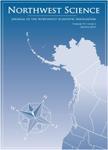版权所有:内蒙古大学图书馆 技术提供:维普资讯• 智图
内蒙古自治区呼和浩特市赛罕区大学西街235号 邮编: 010021

作者机构:US Geol Survey Western Fisheries Res Ctr Columbia River Res Lab Cook WA 98605 USA
出 版 物:《NORTHWEST SCIENCE》 (西北科学)
年 卷 期:2010年第84卷第3期
页 面:233-242页
核心收录:
学科分类:07[理学] 08[工学] 0713[理学-生态学]
基 金:Portland General Electric (PGE) U.S. Fish and Wildlife Service (USFWS) Bureau of Reclamation (BOR) Confederated Tribes of the Grand Ronde (CTGR) Normandeau Associates
主 题:passage behavioral constraint tagging effect Willamette Falls Project impediment Columbia River Fish ladders Willamette River Lampreys PASSAGE Fishes Entosphenus tridentatus Accidental Falls
摘 要:Populations of Pacific lamprey (Entosphenus tridentatus) in the Columbia River basin have declined and passage problems at dams are a contributing factor. We used radio telemetry to monitor the passage of adult Pacific lampreys at the Willamette Falls Project (a hydroelectric dam integrated into a natural falls) on the Willamette River near Portland, Oregon. In 2005 and 2006, fish were captured at the Project. implanted with a radio tag, and released downstream. We tagged 136 lampreys in 2005 and 107 in 2006. Over 90% of the fish returned to the Project in 7 - 9 h and most were detected from 2000 - 2300 h. In 2005, 43 fish (34%) passed the dam via the fishway, with peak passage in August. No fish passed over the falls, but 13% ascended at least partway up the falls. In 2006. 24 fish (23%) passed the Project using the fishway, with most prior to 9 June when the powerhouse was off. Although 19 lampreys ascended the falls, only two passed via this route. The time for fish to pass through the fishway ranged from 4 - 74 h, depending on route. Many fish stayed in the tailrace for hours to almost a year and eventually moved downstream. Our results indicate that passage of lampreys at the Project is lower than that for lampreys at dams on the Columbia River. Low passage success may result from low river flows, impediments in fishways, delayed tagging effects, changing environmental conditions, or performance or behavioral constraints.